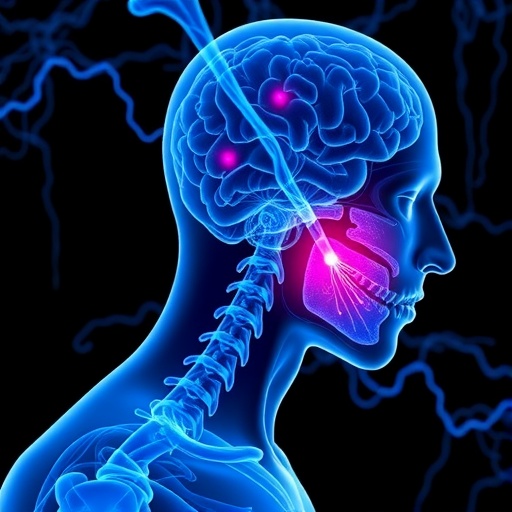A groundbreaking meta-analysis has recently shed new light on the elusive role of glymphatic flow dysfunction in Parkinson’s disease (PD) and the broader Parkinsonism spectrum. Researchers Ghaderi, Mohammadi, Jouzdani, and colleagues have conducted a comprehensive systematic review that compiles the latest data, revealing important mechanistic insights into how impairment in the brain’s glymphatic clearance system might contribute to neurodegenerative processes characteristic of Parkinsonian syndromes. Their findings, published in the prestigious journal npj Parkinson’s Disease in 2025, offer compelling evidence that could pivot future therapeutic approaches and revolutionize our understanding of PD pathophysiology.
The glymphatic system, a relatively recent discovery in neuroscience, operates as the brain’s waste clearance pathway. Utilizing perivascular channels formed by astroglial cells, the system facilitates the movement of cerebrospinal fluid (CSF) through brain parenchyma, effectively removing metabolic waste, proteins, and neurotoxins. Efficient glymphatic clearance is essential for maintaining central nervous system homeostasis, and its dysfunction has now been implicated in a growing list of neurodegenerative disorders, including Alzheimer’s disease. What this new meta-analysis articulates with precision is the extent to which glymphatic impairment overlaps with pathologies observed in Parkinsonism.
Parkinson’s disease, traditionally characterized by the loss of dopaminergic neurons in the substantia nigra and the presence of alpha-synuclein aggregates called Lewy bodies, has long puzzled neuroscientists due to its complex etiopathogenesis. The current meta-analytic work synthesizes data from multiple animal models and human imaging studies to underscore the hypothesis that compromised glymphatic flow exacerbates the buildup of misfolded proteins and oxidative stress within vulnerable brain regions. This pathological cascade could accelerate the neurodegeneration seen in PD, thus linking impaired protein clearance mechanisms directly to the hallmark features of the disease.
Clinically, Parkinson’s disease presents with a spectrum of motor and non-motor symptoms, including bradykinesia, tremor, rigidity, cognitive decline, and autonomic dysfunction. While the symptomatic manifestations have been relatively well cataloged, explaining their underlying molecular and cellular drivers has remained a major challenge. The review highlights that disrupted glymphatic clearance may underlie some non-motor symptoms, notably cognitive impairments, by allowing neurotoxic substances to accumulate in critical cortical and subcortical networks. This perspective enriches the traditional dopaminergic-centric view, broadening diagnostic considerations to include biomarker evaluations of glymphatic function.
Advanced neuroimaging techniques such as diffusion tensor imaging (DTI), dynamic contrast MRI, and novel intrathecal contrast-enhanced protocols have allowed researchers to visualize and quantify glymphatic function in vivo. The meta-analysis draws on studies employing these modalities to demonstrate consistent reductions in glymphatic transport efficiency in PD patients compared to healthy controls. This revelation is pivotal, as it not only validates glymphatic dysfunction as a measurable pathological hallmark but also paves the way for non-invasive diagnostic tools that could detect early-stage disease or monitor therapeutic responses.
Beyond diagnostic potential, the review’s in-depth exploration of glymphatic impairment in Parkinsonism opens new therapeutic avenues. Existing treatments primarily focus on symptom management, often through dopaminergic agents such as levodopa, but none fundamentally alter disease progression. The authors suggest that strategies aimed at restoring or enhancing glymphatic clearance may provide neuroprotective benefits by preventing toxic protein accumulation. This could involve pharmacological modulation of astrocytic aquaporin-4 channels, lifestyle interventions that improve sleep quality—known to augment glymphatic flow—and even novel device-based approaches targeting CSF dynamics.
An intriguing facet emerging from the review is the interplay between sleep disturbances and glymphatic dysfunction in PD. Sleep is a critical modulator of glymphatic activity, particularly during slow-wave sleep when interstitial space expands to facilitate fluid exchange. Patients with Parkinson’s frequently experience sleep disorders, which may create a vicious cycle: impaired sleep reduces glymphatic efficacy, which in turn promotes neurotoxin retention, exacerbating disease symptoms and progression. This insight underscores the potential for sleep quality optimization as an adjunctive treatment strategy to improve glymphatic clearance and slow neurodegeneration.
The meta-analysis also addresses glymphatic variations across the Parkinsonism spectrum, which includes atypical forms such as multiple system atrophy and progressive supranuclear palsy. While these conditions share overlapping clinical features with classic PD, their distinct pathological signatures suggest variations in glymphatic involvement. The compiled data indicate differential patterns of glymphatic impairment, potentially correlating with the selective vulnerability of neuronal populations. This nuanced understanding highlights the importance of tailored therapeutic interventions that address disease-specific glymphatic alterations.
Integral to the study is the rigorous methodology employed in selecting and synthesizing research articles. By systematically combing through a vast array of peer-reviewed studies, the authors mitigate biases and ensure robust, reproducible conclusions. They employ meta-analytic statistical techniques to quantify effect sizes, heterogeneity, and publication bias. This methodological rigor endows the conclusions with significant credibility, reinforcing the critical role of glymphatic dysfunction in the pathogenesis of Parkinsonian disorders relative to background noise from conflicting or heterogeneous studies.
From a molecular perspective, the review delves into the role of astrocytes and their aquaporin-4 (AQP4) water channels, which constitute a linchpin of the glymphatic system. Changes in the polarization and expression of AQP4 have been observed in animal models of Parkinson’s and in post-mortem human brains, indicating dysfunctional water transport. Loss of AQP4 polarization on astrocytic endfeet reduces CSF influx and interstitial fluid clearance, facilitating alpha-synuclein accumulation. This mechanistic pathway is critical for identifying new molecular targets for drug development aiming to restore glymphatic homeostasis.
Importantly, the impact of aging on glymphatic function and subsequent Parkinson’s pathology is addressed extensively. Aging is known to decrease glymphatic efficiency, compounded by pathological protein aggregation and oxidative stress that typify PD. The meta-analysis underscores that age-related glymphatic decline is not a mere epiphenomenon but rather a contributory factor in disease onset and progression. Therapeutic regimens that counteract aging-related glymphatic decline could therefore mitigate the severe clinical burden of late-onset Parkinson’s disease.
Another revolutionary implication of this work is how glymphatic dysfunction may serve as a unifying hypothesis connecting various neurodegenerative diseases. The shared hallmark of proteinopathy, whether alpha-synuclein in PD or beta-amyloid in Alzheimer’s disease, suggests that impaired clearance pathways may represent a common pathway of neuronal injury. The authors postulate that interventions enhancing glymphatic flow could have broad-spectrum neuroprotective applications beyond Parkinsonism, heralding a new era of disease modification strategies in neuroscience.
This meta-analysis also has profound implications for the design of future clinical trials. Biomarkers of glymphatic function could become inclusion criteria or endpoints for evaluating the efficacy of novel drugs or interventions. Such biomarkers may include imaging-based flow measurements, CSF biomarkers indicating protein clearance efficiency, or electrophysiological markers linked to sleep and cerebrovascular dynamics. Integrating glymphatic metrics into clinical research will likely enhance the precision and predictive power of trials aimed at halting or reversing Parkinson’s disease progression.
In summary, the systematic review and meta-analysis by Ghaderi and colleagues provide a compelling synthesis of evidence positioning glymphatic flow dysfunction at the forefront of Parkinson’s disease research. This work brings renewed focus on the brain’s waste clearance mechanisms as critical determinants of neurodegenerative vulnerability. By framing glymphatic system impairment as a modifiable pathological hallmark, this research paves the way for innovative therapeutic targets, highlights the vital importance of sleep and vascular health, and calls for integrative clinical approaches that transcend traditional symptomatic management.
As we stand on the cusp of transforming neurodegenerative disease paradigms, the detailed insights on glymphatic dysfunction in Parkinson’s and Parkinsonism spectrum disorders offer a timely beacon of hope. Harnessing these discoveries could lead to breakthrough treatments that not only alleviate symptoms but quell the underlying disease process, ultimately enhancing the quality of life for millions affected worldwide. The scientific community and clinicians alike await the translation of these insights into practical interventions with eager anticipation.
Subject of Research:
Glymphatic flow dysfunction in Parkinson’s disease and Parkinsonism spectrum disorders.
Article Title:
A systematic review and meta-analysis on glymphatic flow dysfunction in Parkinson’s disease and Parkinsonism spectrum.
Article References:
Ghaderi, S., Mohammadi, S., Jouzdani, A.F. et al. A systematic review and meta-analysis on glymphatic flow dysfunction in Parkinson’s disease and Parkinsonism spectrum. npj Parkinsons Dis. 11, 306 (2025). https://doi.org/10.1038/s41531-025-01151-4
Image Credits:
AI Generated
Tags: alpha-synuclein aggregatesastroglial cell functionbrain waste clearance pathwayscentral nervous system homeostasiscerebrospinal fluid clearanceGlymphatic flow dysfunctionmeta-analysis on Parkinson’sneurodegenerative diseasesParkinson’s disease mechanismsParkinson’s disease pathophysiologyParkinsonism spectrumtherapeutic approaches for Parkinson’s





